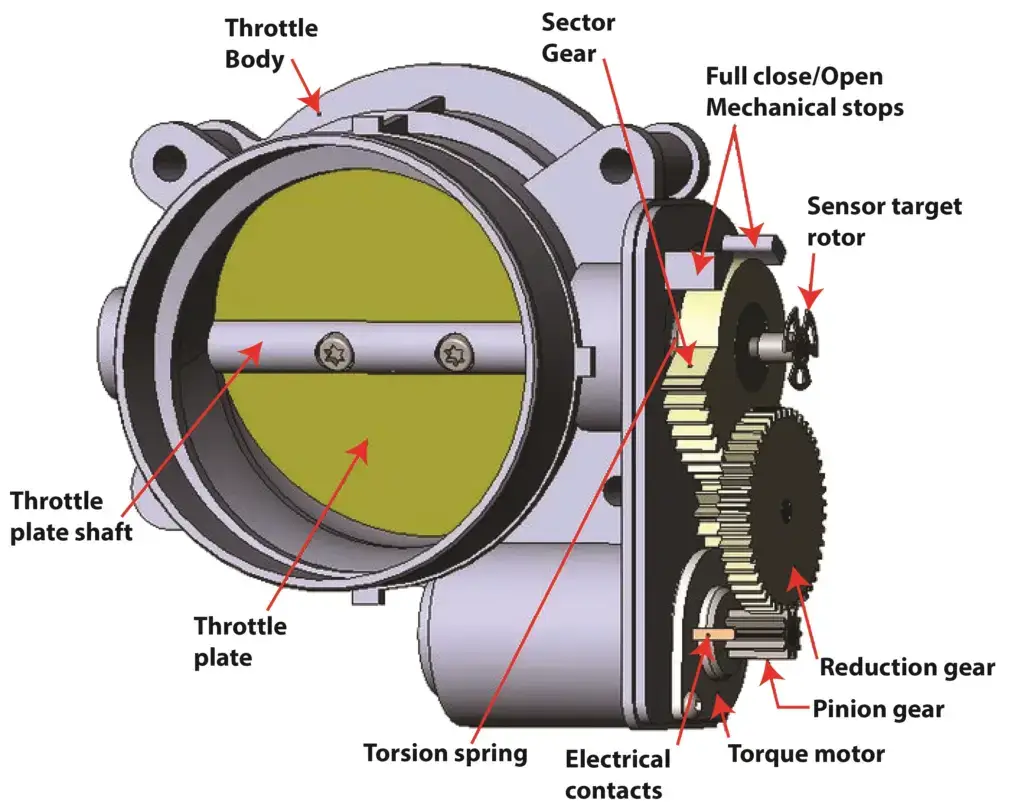Diagnose electronic throttle body trouble codes
Here are the most common throttle body codes and what they mean
Understanding electronic throttle body components
All throttle-by-wire throttle systems have the same basic parts.
Throttle body with throttle plate that opens and closes to control the amount of air air entering the engine. The plate movement is accomplished with an electric motor connected to the throttle plate by a series of gear to provide gear reduction advantage.
Two or more throttle position sensors, usually built into the electronic portion of the throttle body. The sensors vary resistance based on the angle of the throttle plate and that data is sent to the ECM. The multiple sensors act as redundancy and operate in opposite resistance; one sensor will increase resistance as the throttle angle is increased, one sensor will reduce resistance as the throttle angle is reduced. The ECM provides multiple five-volt reference signals to the sensors. On some designs, the multiple signal voltages must add up to five-volts (the rising voltage plus the falling voltage) in order to make sense the ECM. The ECM shares the calculated throttle angle with the ABS, transmission and other modules.
Most common electronic throttle body trouble codes
P0120-P0124 are for sensor A.
P0220-P0224 are for sensor B.
P0225-P0229 are for sensor C.
The codes in the three sets cover circuit malfunctions like high or low inputs. These codes indicate an issue with the throttle body throttle position sensors or the wiring harness or connectors.
Use the live data on a scan tool or a multimeter to check for proper operation of the throttle position sensors.
The single most common electronic throttle body trouble code is P2119 Throttle Actuator Control Throttle Body Range/Performance. This ECM sets this code when the commanded throttle plate angle does not match the actual throttle position angle as reported by the throttle position sensors. This is referred to as a plausibility code, meaning the computer can’t make sense of the incoming data.
Most common causes of P2119
P2119 can be caused by a either a mechanical or electrical problems. For example, a change in throttle angle change should immediately alter the signal being sent from the mass airflow sensor or manifold air pressure sensor. If it doesn’t, a P2119 can be set.
Carbon buildup in the throttle body or a dirty MAF sensor can cause this. Check those two items first when diagnosing a P2119
Are there other trouble codes?
Check for codes in other modules for loss of communication. Resolve those trouble codes before addressing the throttle body related trouble codes.
Diagnose P2119
Using scan tool live data, compare the commanded and actual throttle angle values. On most vehicles, these two data PIDs should match. Next, check for proper reference voltages to all throttle position sensors. The reference voltages should all be the same and must match specs in the shop manual.
If those values check out, look at the signal voltages of sensors A and B. For most vehicles, when you add up the two signal voltages they should equal the reference voltage.
©, 2023 Rick Muscoplat
Posted on by Rick Muscoplat
